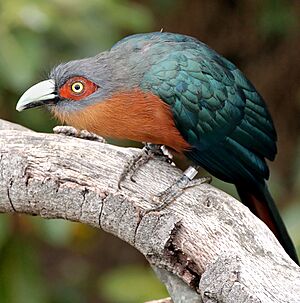Chestnut-breasted malkoha facts for kids
Quick facts for kids Chestnut-breasted malkoha |
|
|---|---|
 |
|
| immature | |
| Conservation status | |
| Scientific classification | |
| Genus: |
Phaenicophaeus
|
| Species: |
curvirostris
|
The chestnut-breasted malkoha (Phaenicophaeus curvirostris) is a special type of cuckoo bird. It lives in Southeast Asia, from Myanmar all the way to eastern Java, the Philippines, and Borneo. This is a large cuckoo, growing up to 49 cm (about 19 inches) long. It has grey and dark green feathers on its back and chestnut-colored feathers on its belly. One of its most noticeable features is its large, curved, pale beak. Male and female malkohas look very similar. Unlike many other cuckoos, this bird builds its own nest and takes care of its babies!
Contents
Meet the Chestnut-breasted Malkoha
The chestnut-breasted malkoha was first described by an English scientist named George Shaw in 1810. He found a specimen in western Java. Later, another scientist named James Francis Stephens created the group (genus) called Phaenicophaeus for birds like this one.
The name curvirostris comes from Latin words. Curvus means "curved," and rostrum means "beak." So, its name literally means "curved beak," which perfectly describes this bird!
Different Types of Malkohas
Scientists recognize six different types, or subspecies, of the chestnut-breasted malkoha. These types live in slightly different areas:
- P. c. singularis: Found in southern Myanmar, Thailand, the Malay Peninsula, Sumatra, and the Anambas islands.
- P. c. oeneicaudus: Lives on islands west of Sumatra.
- P. c. curvirostris: Found in central and western Java.
- P. c. deningeri: Lives in eastern Java and Bali.
- P. c. microrhinus: Found on Bangka Island and Borneo.
- P. c. harringtoni: Lives on Palawan, Balabac, Calamian, and Dumaran islands in the western Philippines.
What Does It Look Like?
The chestnut-breasted malkoha is about 42 to 49 cm (16.5 to 19 inches) long. It has a big, curved beak. The top part of its beak is pale yellow, and the bottom part is darker, either red or black. Around its eye, there's a patch of bare red skin.
Its head is grey, and its wings are dark green. As the bird gets older, its wings might turn a bit blue. Its belly and lower back are a rich chestnut color. Its feet are dark grey. Males and females look very much alike. However, the male has pale blue eyes, while the female has yellow eyes.
Where Do They Live?
You can find the chestnut-breasted malkoha in several countries in Southeast Asia. These include Brunei, Indonesia, Malaysia, Myanmar, the western Philippines, and southern Thailand.
Their favorite places to live are moist lowland forests and mangrove forests. They usually stay in the middle part of the trees, hidden among the thick leaves. Sadly, some of their forest homes are being cleared away.
What Do They Eat?
The chestnut-breasted malkoha is a skilled hunter! It eats small animals like tiny lizards, frogs, and even baby birds. It also enjoys a variety of insects. These include caterpillars, grasshoppers, cicadas, stick insects, mantises, cockroaches, beetles, and other bugs. Sometimes, they will also eat spiders and small crabs.
Raising a Family
Unlike many other cuckoos, the chestnut-breasted malkoha is a responsible parent. It builds its own nest and raises its own young. The time of year when they breed can change depending on where they live. For example, in Borneo, it's from August to December, but in other parts of Southeast Asia, it's from January to September.
Both the male and female work together to build a nest. It's usually about 35 cm (14 inches) wide and made of small branches and twigs. Inside, they make a cup-shaped area lined with leaves. This cup is about 11 cm (4.3 inches) wide and 5 cm (2 inches) deep.
The female usually lays two or three matte white eggs. Each egg is about 34 x 28 mm in size. Both parents take turns sitting on the eggs to keep them warm. The eggs usually hatch after about 13 days. The baby birds stay in the nest for around 11 days. During this time, both parents bring them food.


